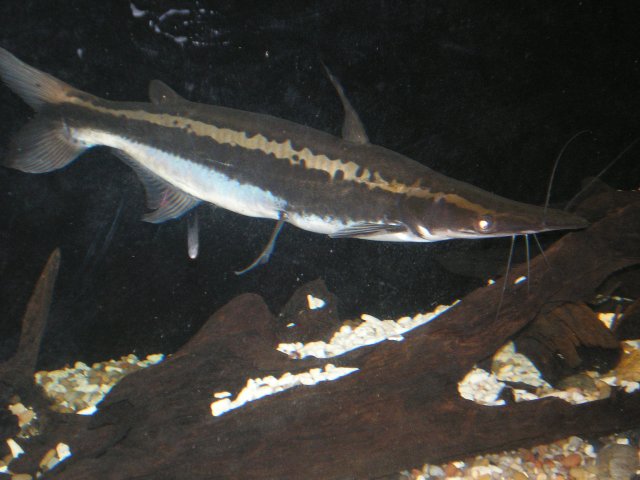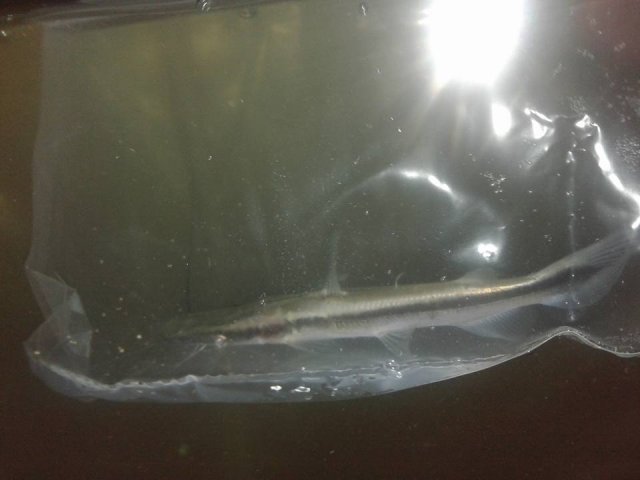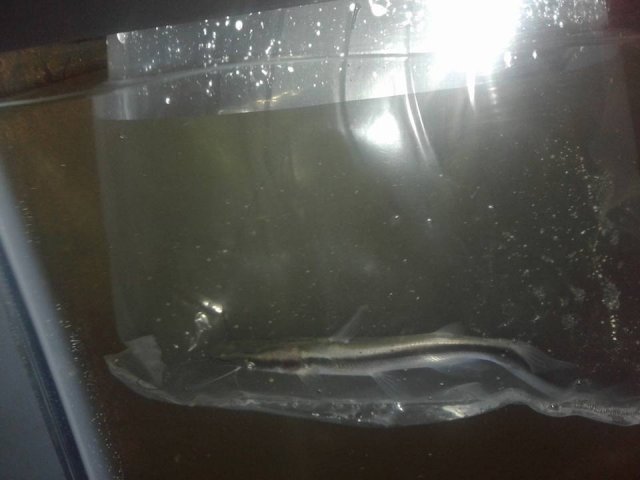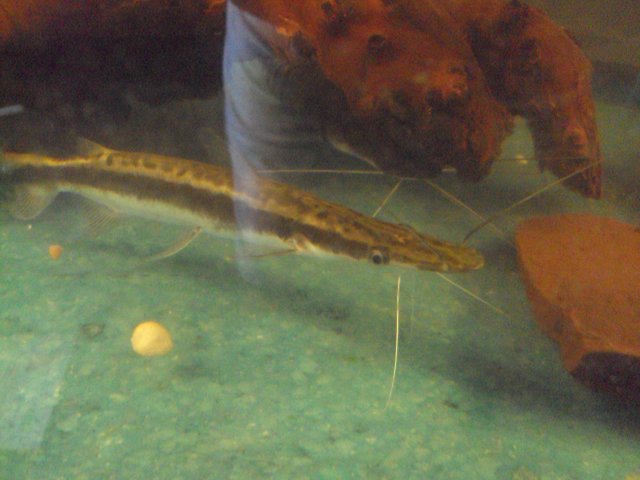A
AquaAlex1993
Guest
This week’s freshwater fish profile is on a catfish that I really enjoy and love!! It’s a catfish that is in a family that typically has giant monster sized catfish such as Red Tail Catfish, Tiger Shovelnose catfish and other large growing catfish from South America. The Lima Shovelnose is one of my favorite South American catfish, nice body shape that resembles a hockey stick and they grow to a decent manageable size. I will talk about their manageable sizes and their family of other South American Catfish Pimelodidae.
Looking for a catfish that can live in your large community aquarium? Looking for an oddball type catfish? Want an active catfish with a unique shape to swim in your aquarium? Consider the Lima Shovelnose catfish! Now, let me discuss the Lima Shovelnose with all of you.
Lima Shovelnose Catfish (Sorubim Lima)
Common Names: Lima Shovelnose, Duckbill Catfish, Duck-beak catfish, Common Shovelnose catfish, Shovelnose catfish
Scientific Name: Sorubim Lima
Family: Pimelodidae , Lima Shovelnose catfish are in the same family as other common aquarium pim catfish such as Red Tailed Catfish, tiger shovel nose catfish, pictus catfish, and four lined pictus among others.
Genus: Sorubim
Natural Habitat: Lima Shovel nose catfish live all over the Amazon. They are found in Venezuela, Ecuador, Colombia, Peru, Brazil, Orinoco and more! They have been collected from both open, flowing sections of rivers/tributaries and quieter habitats such as floodplain lakes and oxbows but mostly inhabits cloudy turbid white water rivers. Juveniles often form aggregations around thickets of grasses and reeds or among submerged woody structures such as tree roots.
Full Grown Size: Lima shovel nose have a size range of 12-18’’ in the aquarium hobby. In the wild, some can reach 20’’ but the average size in the aquarium hobby is anywhere from 12-18’’. They are more manageable than the Tiger Shovel nose which can reach several feet.
Tank Size: Unlike the Tiger Shovel Nose, a Lima Shovel Nose does not require a 500 to a 1,000 gallon aquarium although they’d love the space!!!!

 With them growing to over 1’, I personally recommend 90 gallons and up. Ideally, a 6’ 125 to 220 gallon aquarium would be perfect for 1 or 2.
With them growing to over 1’, I personally recommend 90 gallons and up. Ideally, a 6’ 125 to 220 gallon aquarium would be perfect for 1 or 2.
Maintenance: Lima Shovel nose catfish by nature are nocturnal which means they are the most active at night. You will need to provide your Lima Shovel Nose catfish plenty of hiding spaces in order for it to feel secure. You can use driftwood caves, rock formation caves, or even plastic plants or real plants. Just to give them something to hide in in case they get stressed out. Over filtration is recommended for any fish that grows over a foot. Provide oxygen in the water with the help of a wave maker or airstone (in my personal opinion, ditch the air stones and save them for a small aquarium, wave makers are the way to go in a large aquarium). While Lima shovel nose catfish are quite hardy, they need clean water. I recommend doing 2 water changes a week,
Water Conditions: Temperature 74-86 DEGREES F, P.H. 6.0-7.5
Diet: Like all South American catfish, Lima shovel nose catfish are not hard to feed at all. They will eat everything pretty much including the kitchen sink! By nature they are carnivorous, which means they love meat! I recommend that you provide a diet that will consist of shrimp, chopped up pieces of fish such as Cod and Flounder and I highly recommend that you incorporate earthworms into their diet as it provides a lot of nutrition for them. Pellet foods that are high in meat may also be used, but not all Lima shovel nose catfish will accept pellets. But, once established in the aquarium they may accept pretty much anything. I should forewarn you that feeding Live feeder goldfish is something I tell people NOT to do! Goldfish provide no nutritional value to any fish. Some of the lipids contained in feeder goldfish cannot be properly metabolized by the fish, and can cause excess deposits of fat and even organ degeneration. Similarly there is no benefit in the use of ‘feeder’ fish such as livebearers or small goldfish which carry with them the risk of parasites or diseases. If you must experience a Live Feeding for your Lima shovel nose, breed and raise your own livebearers, gut feed them with quality food and make sure they are healthy.
Tankmates: AVOID ANYTHING THAT IS SO SMALL IT CAN BE EATEN! Don’t even consider a Lima Shovel Nose catfish if you have small fish. Besides the fact that they will eat any fish that can fit in their mouths , they are actually quite peaceful. Keep them with bigger fish. Good tankmates include: Myleus, Metynnis silver dollar species, SemaProchilodus flag tails, other larger characins, cichlids such as Chocolate cichlids, angelfish, severums, other catfish such as pictus cats and medium to large growing cats, plecos, and more.
Other Information on Lima Shovel Nose Catfish: Did you know that there are 5 different species of Lima shovel nose catfish? Sorubim currently contains five recognized species which are Sorubim Elongatus (slender shovel nose catfish), Sorubim cuspicaudus, Sorubim Lima, Sorubim maniradii,and Sorubim Trigonocephalus. Check out Planet Catfish for pictures of the different species!
Aqua Alex’s Final Information on Lima Shovel Nose Catfish:
Lima Shovel Nose catfish are one of the best medium to large growing catfish available in the aquarium hobby. They grow WAY smaller than Tiger shovel nose and red tailed catfish. Don’t get me wrong, I love those catfish too, but let’s face it they don’t belong in the hobby due to their size they reach. Lima Shovel Nose also are one of the only shovel nose species to show off their shovel nose with a hockey stick stance. It is one of the coolest things ever. They are readily available in the aquarium hobby and have a price tag of $15 to $40 depending on the local market.
When you get a new Lima Shovel Nose catfish, do not fret if the Lima Shovel Nose catfish hides and isn’t active for a few days, he is getting used to his surroundings. He will eventually get used to his tank, and become more bold and ready for food. In my personal experience with my lima shovel nose since I have a lot of plastic plants and hiding spots, my lima is very active. I personally recommend supplying plenty of caves for your lima shovel nose.
My last thought: Looking for a medium to large odd ball catfish that has a unique look? Looking for a catfish from South America? The Lima Shovel Nose is the catfish for you. Consider getting one if you don’t have one already.
Lima Shovel Nose catfish are my favorite catfish for a reason it’s because they are a shovel nose I can keep for life.
I hope you will consider adding a Lima shovel nose to your tank if you don’t have one already! If you have any further questions on Lima shovel nose catfish, feel free to ask away!
Thanks and have a nice fish keeping day!
Sincerely,
Aqua Alex Cardinale
Host of Exotic Tropical Fish on AC Network



Looking for a catfish that can live in your large community aquarium? Looking for an oddball type catfish? Want an active catfish with a unique shape to swim in your aquarium? Consider the Lima Shovelnose catfish! Now, let me discuss the Lima Shovelnose with all of you.
Lima Shovelnose Catfish (Sorubim Lima)
Common Names: Lima Shovelnose, Duckbill Catfish, Duck-beak catfish, Common Shovelnose catfish, Shovelnose catfish
Scientific Name: Sorubim Lima
Family: Pimelodidae , Lima Shovelnose catfish are in the same family as other common aquarium pim catfish such as Red Tailed Catfish, tiger shovel nose catfish, pictus catfish, and four lined pictus among others.
Genus: Sorubim
Natural Habitat: Lima Shovel nose catfish live all over the Amazon. They are found in Venezuela, Ecuador, Colombia, Peru, Brazil, Orinoco and more! They have been collected from both open, flowing sections of rivers/tributaries and quieter habitats such as floodplain lakes and oxbows but mostly inhabits cloudy turbid white water rivers. Juveniles often form aggregations around thickets of grasses and reeds or among submerged woody structures such as tree roots.
Full Grown Size: Lima shovel nose have a size range of 12-18’’ in the aquarium hobby. In the wild, some can reach 20’’ but the average size in the aquarium hobby is anywhere from 12-18’’. They are more manageable than the Tiger Shovel nose which can reach several feet.
Tank Size: Unlike the Tiger Shovel Nose, a Lima Shovel Nose does not require a 500 to a 1,000 gallon aquarium although they’d love the space!!!!

Maintenance: Lima Shovel nose catfish by nature are nocturnal which means they are the most active at night. You will need to provide your Lima Shovel Nose catfish plenty of hiding spaces in order for it to feel secure. You can use driftwood caves, rock formation caves, or even plastic plants or real plants. Just to give them something to hide in in case they get stressed out. Over filtration is recommended for any fish that grows over a foot. Provide oxygen in the water with the help of a wave maker or airstone (in my personal opinion, ditch the air stones and save them for a small aquarium, wave makers are the way to go in a large aquarium). While Lima shovel nose catfish are quite hardy, they need clean water. I recommend doing 2 water changes a week,
Water Conditions: Temperature 74-86 DEGREES F, P.H. 6.0-7.5
Diet: Like all South American catfish, Lima shovel nose catfish are not hard to feed at all. They will eat everything pretty much including the kitchen sink! By nature they are carnivorous, which means they love meat! I recommend that you provide a diet that will consist of shrimp, chopped up pieces of fish such as Cod and Flounder and I highly recommend that you incorporate earthworms into their diet as it provides a lot of nutrition for them. Pellet foods that are high in meat may also be used, but not all Lima shovel nose catfish will accept pellets. But, once established in the aquarium they may accept pretty much anything. I should forewarn you that feeding Live feeder goldfish is something I tell people NOT to do! Goldfish provide no nutritional value to any fish. Some of the lipids contained in feeder goldfish cannot be properly metabolized by the fish, and can cause excess deposits of fat and even organ degeneration. Similarly there is no benefit in the use of ‘feeder’ fish such as livebearers or small goldfish which carry with them the risk of parasites or diseases. If you must experience a Live Feeding for your Lima shovel nose, breed and raise your own livebearers, gut feed them with quality food and make sure they are healthy.
Tankmates: AVOID ANYTHING THAT IS SO SMALL IT CAN BE EATEN! Don’t even consider a Lima Shovel Nose catfish if you have small fish. Besides the fact that they will eat any fish that can fit in their mouths , they are actually quite peaceful. Keep them with bigger fish. Good tankmates include: Myleus, Metynnis silver dollar species, SemaProchilodus flag tails, other larger characins, cichlids such as Chocolate cichlids, angelfish, severums, other catfish such as pictus cats and medium to large growing cats, plecos, and more.
Other Information on Lima Shovel Nose Catfish: Did you know that there are 5 different species of Lima shovel nose catfish? Sorubim currently contains five recognized species which are Sorubim Elongatus (slender shovel nose catfish), Sorubim cuspicaudus, Sorubim Lima, Sorubim maniradii,and Sorubim Trigonocephalus. Check out Planet Catfish for pictures of the different species!
Aqua Alex’s Final Information on Lima Shovel Nose Catfish:
Lima Shovel Nose catfish are one of the best medium to large growing catfish available in the aquarium hobby. They grow WAY smaller than Tiger shovel nose and red tailed catfish. Don’t get me wrong, I love those catfish too, but let’s face it they don’t belong in the hobby due to their size they reach. Lima Shovel Nose also are one of the only shovel nose species to show off their shovel nose with a hockey stick stance. It is one of the coolest things ever. They are readily available in the aquarium hobby and have a price tag of $15 to $40 depending on the local market.
When you get a new Lima Shovel Nose catfish, do not fret if the Lima Shovel Nose catfish hides and isn’t active for a few days, he is getting used to his surroundings. He will eventually get used to his tank, and become more bold and ready for food. In my personal experience with my lima shovel nose since I have a lot of plastic plants and hiding spots, my lima is very active. I personally recommend supplying plenty of caves for your lima shovel nose.
My last thought: Looking for a medium to large odd ball catfish that has a unique look? Looking for a catfish from South America? The Lima Shovel Nose is the catfish for you. Consider getting one if you don’t have one already.
Lima Shovel Nose catfish are my favorite catfish for a reason it’s because they are a shovel nose I can keep for life.
I hope you will consider adding a Lima shovel nose to your tank if you don’t have one already! If you have any further questions on Lima shovel nose catfish, feel free to ask away!
Thanks and have a nice fish keeping day!
Sincerely,
Aqua Alex Cardinale
Host of Exotic Tropical Fish on AC Network














